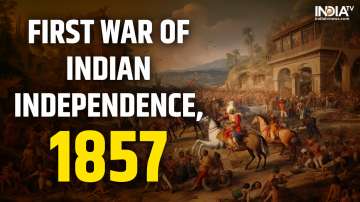First War of Indian Independence in 1857: History, origin, causes, impact and other details
The first war of Indian Independence began on May 10, 1857 in the form of a mutiny of sepoys of the Company's army in Uttar Pradesh's Meerut. It then erupted into other mutinies and civilian rebellions in northern and central India.

Independence Day 1857: The Indian Rebellion of 1857 was a major uprising in India in 1857–58 against the rule of the British East India Company, which functioned as a sovereign power on behalf of the Britishers.
It began on May 10, 1857 in the form of a mutiny of sepoys of the Company's army in Uttar Pradesh's Meerut. It then erupted into other mutinies and civilian rebellions in northern and central India.
Rebellion posed threat to British power
The rebellion posed a military threat to British power, and was contained only with the rebels’ defeat in Gwalior on 20 June 1858.
On November 1, 1858, the British granted amnesty to all rebels not involved in murder, though they did not declare the hostilities to have formally ended until 8 July 1859.
First war of Indian Independence also known as:
The first war of Indian Independence is also described as the Sepoy Mutiny, the Indian Mutiny, the Great Rebellion, the Revolt of 1857, the Indian Insurrection, and the First War of Independence.
What caused the revolt of 1857?
Historians have identified diverse political, economic, military, religious and social causes of the Indian Rebellion of 1857.
Underlying grievances over British taxation and recent land annexations by the English East India Company (EEIC) angered Indians and within weeks, dozens of units of the Indian army joined peasant armies in widespread rebellion.
Both Hindus and Muslims rebelled against British rule. Some Indians were upset with the draconian rule of the East India Company who had embarked on a project of territorial expansion and westernization that was imposed without any regard for historical subtleties in Indian society.
Furthermore, legal changes introduced by the Britishers were accompanied by prohibitions on Indian religious customs and were seen as steps towards forced conversion to Christianity.
The role of Rani Lakshmibai
Rani Lakshmibai, also known as the Rani of Jhansi, played a significant role in the First War of Indian Independence. She was one of the prominent figures who led the resistance against British colonial rule during this uprising. Her actions and leadership have made her a symbol of courage and defiance in India's struggle for independence.
Rani Lakshmibai was the queen of the princely state of Jhansi in north-central India. After the death of her husband, Maharaja Raja Gangadhar Rao, and the British refusal to recognize her adopted son as the rightful heir to the throne, tensions between the British authorities and Rani Lakshmibai escalated.
When the rebellion began in 1857, Rani Lakshmibai actively joined the fight against the British. She refused to surrender her kingdom to the British and took up arms to defend her people and her territory. Her leadership skills, strategic acumen, and personal bravery inspired her troops to fight with determination.
One of the most well-known incidents associated with Rani Lakshmibai's involvement in the rebellion is the Siege of Jhansi. The British forces attacked Jhansi, and the Rani fiercely defended her city. She led her forces in battle and became a symbol of resistance. Eventually, Jhansi fell to the British, but Rani Lakshmibai managed to escape and continued to lead the rebellion in other regions.
Tragically, Rani Lakshmibai died in battle on June 17, 1858, while fighting against the British in Gwalior. Despite her death, her legacy lived on as a symbol of courage, patriotism, and the fight for freedom. Her role in the First War of Indian Independence is celebrated in Indian history and culture, and she remains an iconic figure in India's struggle for independence from British colonial rule.
Did India win the war?
India did not gain independence after the First War of Independence 1857.
The Indian independence movement was a series of historic events with the ultimate aim of ending British rule in India. It lasted from 1857 to 1947.
India got its independence from the British rule on August 15, 1947.
ALSO READ | Indian Railways suspends THIS service till Independence Day
ALSO READ | Independence Day 2023: Know history, importance and its significance